Thanks the rise of competitive shooting leagues such as PRS and movies such as American Sniper, precision rifles have been gaining popularity Does the American Rifle Company’s innovative “Mausingfield” action meet the market demand for an improved Mauser-style receiver maximized for long-range accuracy? . . .
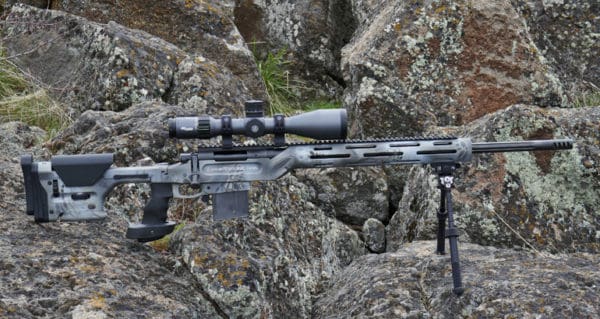
I discovered the Mausingfield action at SHOT Show 2016, when I meet Theodore (“Ted”) Karagias, President and chief engineer of Seattle-based American Rifle Company, Inc.
A shiny carbon fiber stock on his table lured me in. But it was the Mausingfield buttery smooth action and Ted’s intelligent explanation of his products that convinced me I needed to get in on this action. So to speak.
Over the summer of 2016, I commissioned Long Rifles’ Inc. of Sturgis, South Dakota to build the rifle. I paid Club Custom Guns of Denton, North Carolina to polish and finish the action and barrel assembly in Ionbond (a type of diamond-like coating).
Mausingfield Action
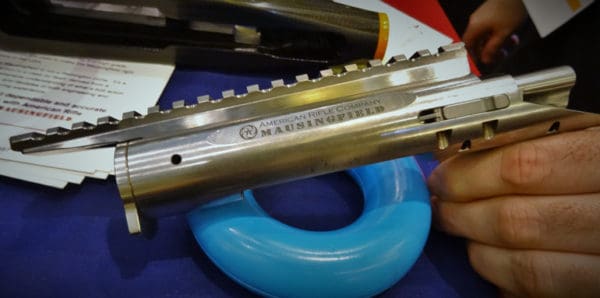
Most of the popular precision actions on the market today are based on the Remington 700 action. While the action’s capable of tremendous accuracy, the gun made its bones via fast lock times and the simplicity of design (a.k.a., lower production costs).
The Remington 700 push-feed action lacks the control round feeding and the beefy external leaf spring extractor that’s the hallmark of the Mauser action. The pluses and minuses of these two competing actions have been the topic of much debate around the camp fire of deer camps for years.
Suffice it to say, the Mausingfield action updates Paul Mauser’s classic bolt-action design to meet the needs of the modern precision shooter.
The Mausingfield action is forged out of 4340 alloy steel (hardened to Rockwell 53c) and has the following key features:
– Interchangeable bolt heads support multi-caliber rifles
– Toroidal bolt lugs that do not require lapping
– Mauser 98 claw extractor
– Model 1903 Springfield inertial ejector
– Secure and interchangeable interlocking rail interface
– Ergonomically designed bolt knob (interchangeable).
– Integral recoil lug for increased thread engagement between the barrel and the receiver.
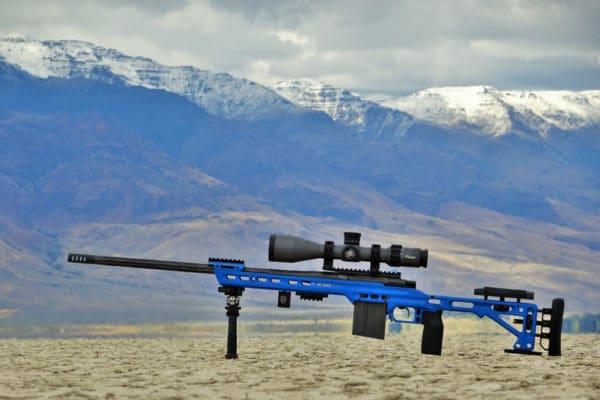
When I bought my action from Ted, they only came in white. Ted now finishes the receiver in a black DLC and the bolt in a black Salt Nitride finish. Given that the retail price of the action hasn’t changed, it saves the consumer significant time and money.
One cool feature worth noting: the aft end of the Mausingfield’s bolt is slightly flared so that it locks up very tightly with the action. This is more or less the same idea as the bolt “sleeves” that you see when a gunsmith “blueprints” a Remington 700 action, except here it’s built into the bolt design.
Toridal Bolt Lugs.
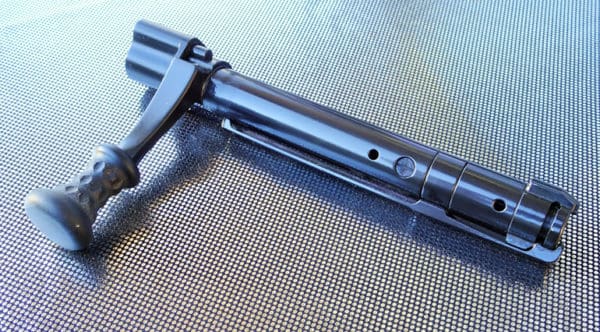
Toroidal bolt lugs
In geometry, a torus is a surface of revolution generated by revolving a circle in three-dimensional space about an axis coplanar with the circle. Basically, think “donut.” Designing the bolt lugs as a torus allows the bolt lugs to find the natural center within the receiver. Ted Karagais explains:
The Mausingfield bolt head has two diametrically opposed locking lugs. The bearing surfaces of the locking lugs are shaped as portions of a torus, and bear against surfaces within the receiver that are shaped as portions of a sphere.
Regardless of the alignment between the bolt and receiver, these bearing surfaces maintain contact along arcs that approximately bisect the bearing surfaces of the lugs. When the rifle is fired, the bearing surfaces are elastically flattened against one another, enabling proper load sharing between the lugs, thus increasing the load-bearing capacity of the breech.
That’s engineer-speak for saying that the donut on the end of the bolt locks up with the bowl-shaped receiver for a tight fit. No need to pay big bucks to a gunsmith to “blueprint” or “lap” like you would a Remington 700 action.
Also, there’s no need to use an articulating bolt head design like the one used by Savage Model 10 action. Although an articulating bolt head also does not require lapping, it cannot be made to work with a Mauser extractor design.

Another advantage of the toridial bolt heads of the Mausingfield action: they’re interchangeable, well-suited for cost-effective multi-caliber rifles that use Mauser extractors. As Ted explains:
The Mausingfield receiver and bolt are designed to properly engage one another when the bolt is closed, regardless of the alignment between the two. The design obviates the need for lapping, as well as the need for an articulating bolt head.
The Mausingfield uses a main bolt body connected to a non-articulating bolt head by a pin. We chose the two-piece bolt design to facilitate the assembly of the bolt with the Mauser type extractor and its retaining collar, as well as to support the use of interchangeable bolt heads and extractors for multi-caliber rifles.
Since lapping is unnecessary, bolt heads are never matched to the receiver. Therefore, reconfiguring the bolt is a simple matter of disassembling and then reassembling with the appropriate bolt
The Mausingfield is tolerant of dirt and other contaminants likely encountered in adverse field conditions. Additionally, it allows for the use of paint finishes such as Cerakote. Personally, I vastly prefer a DLC coating over Cerekote because DLC has a lot less friction and has better metal-to-metal abrasion resistance.
Interlocking Rail Interface.
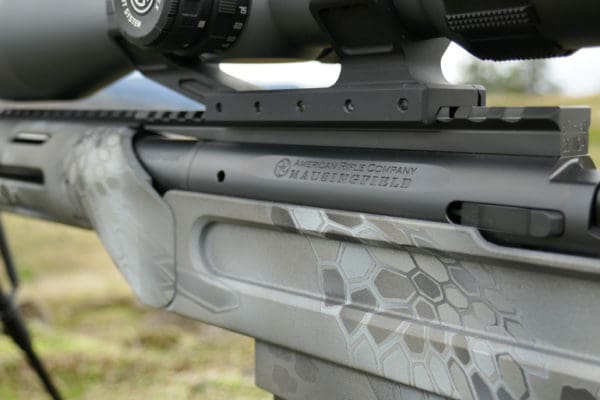
I’ve always been a big fan of integral rails; loose scope mounts are a common source of problems. I’ve seen multiple instances where the rail screws came loose on my buddies’ rifles, causing errant shots. I’ve also seen cases where steel screws had eaten into the softer aluminum rail, causing the rail to loosen.
When you have a heavy scope mounted on a smooth action, the recoil can take its toll over time. However, integral rails lack flexibility in terms of the cant that is built into the system. Furthermore, if you damage the rail, you basically have to start over with a new action.

The Mausingfield offers the flexibility of an removable rail with the strength and rigidity of an integral.
ARC mills a tapered key into the top of the receiver (kinda shown above), as a well as a matching tapered slot into the bottom of the rail. The rail fits precisely into the raised area on the receiver, making the receiver act as a recoil lug.
This design effectively prevents the rail from moving under recoil. In fact, when you screw the rail down onto the receiver, you can take the screws out and the rail will remain tight to the receiver until considerable force is applied to remove it.
ARC does not use the typical tiny-ass screws you usually see on a factory rifle. They use five 8/36 by ¼ inch long socket head cap screws — creating an interference fit between the two that acts as a recoil lug.

You can also change the cant on the rail if needs be.
ARC makes the rails with 20 MOA, 30 MOA, and 45 MOA of cant. I chose 30 MOA (8.7 Mrad), which turned out to be the right call.
With the SIG SAUER Tango 6 5-30×56 scope, I have 19.5 Mils of elevation available, which should get me out to 1600 yards. Without that extra cant, my my range would’ve topped out at roughly 1150 yards.
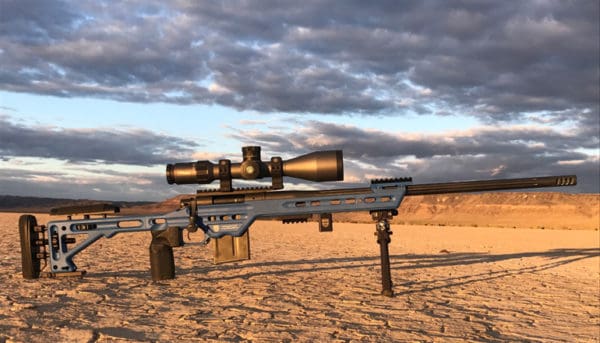
Compatibility.
The Mausingfield action is designed to interface with a wide variety of popular components. It’s compatible with:
– Accuracy International (AICS) magazines
– Savage small shank barrels and locknuts
– Remington 700 Triggers
– Remington 700 Stocks and Chassis systems
The Savage barrel interface is a big deal. You can change out barrels at the end-user level without any expensive equipment or custom machining.
Many companies produce off-the-shelf turn-key barrels that interface with the with Savage system, including the sexy Proof Research carbon fiber barrel. Your rifle spends less time redlined at the gunsmith shop.
The Mausingfield’s ability to utilize Remington 700 compatible stocks is also a big plus.
Remmy 700 is by far the most ubiquitous rifle design. I have two chassis that I use with the Mausingfield: the JP AMAC and the Masterpiece Arms BA competition chassis. Even my Christensen Arms carbon chassis will fit the Mausingfield. Your options are limitless.
Ejector

The Mausingfield ejector takes its design ques from the Model 1903 Springfield. The ejector is located at the aft end of the receiver. As the bolt moves to the rear, the ejector pivots into engagement with the case head through a slot in the bolt face.
This system has a number of advantages over the more common spring-plunger ejector.
The Springfield ejection system is robust and reliable and less susceptible to dirt and contaminants than other types. It doesn’t rely on a spring, so no periodic maintenance is required.
And the Springfield ejector also enables the shooter to control the intensity of the ejection process.
ARC M-10 Scope Rings

When I originally set up this rifle, I used a JP 34mm Flat Top Scope Mount. At $180.00, this is a first-quality mount at a value price when compared to the popular Geissele and Spuhr one-piece mounts.
I ended up using the JP mount on an AR build, for which it’s optimized. To replace it, I bought a set of ARC M-10 two-piece rings. Ted recommended the two-piece rings for bolt guns due to their increased flexibility when mounting them to the rail.
Ted told me that “all rings suck, but mine just suck a little less than the others.” His is a bold statement for sure, but Ted has good reason to be proud of his design.
Conventional rings can cause the scope to cant ever-so-slightly as the screws are tightened. The M-10 rings are a hinged “split-ring” design, maintaining reticle alignment during scope installation. The split rings help prevent marring the scope. And they have a low profile, leaving the shooter with a clear view of the turrets.
The M-10 Rings are CNC machined from 7075 aluminum alloy and anodized with a mil-spec hard coat for excellent corrosion resistance and a matte-black finish. They also feature a crowned-rail interface which precisely and correctly engaged rails — even those which fail to meet Mil and STANAG specification.
The result is excellent return-to-zero performance.
The M-10 uses high strength 410 stainless cross bolt. Recommended torque for both rail clamp and scope clamp screws is 5.6-6.2 Nm (50-55 in-lbs).
Long Rifles Inc.
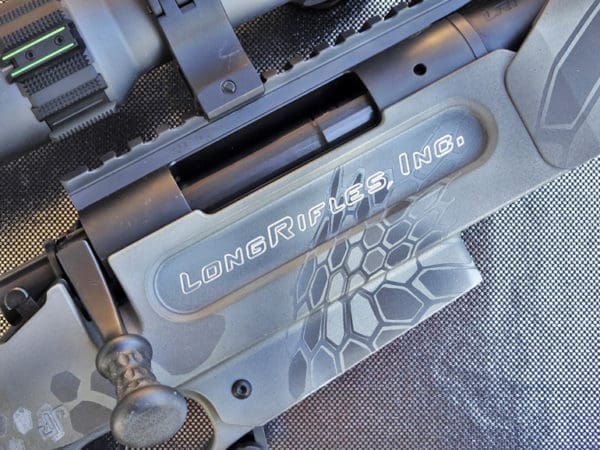
Ted recommended Chad Dixon at Long Rifles Inc. as my rifle builder; Chad has a lot of experience with the Mausingfield actions. Working with LRI was a great experience.
LRI’s customer service was excellent. I was a “first timer” custom bolt gun guy, so I had lots of noob questions. The LRI staff spent a lot of time on the phone with me. We sent a large number of detailed emails back and forth.
The scope of work and expectations were well laid out in their proposals. Perhaps more importantly, the LRI staff answer their phones, and if I called asking for a specific person that was busy, they were really good about calling back.
LRI was also good at getting the work done on time. So many gunsmiths I know take months to get projects done. LRI was Johnny-on-the-spot.
LRI took about a month to finish the barreled action. They then sent the Barreled action to Club Custom. There the action gets further polished and then sent to Ion Bond for coating. Club estimated it would take about two months; it ended up being closer to five months. The problem was at Ion Bond, not Club Custom. Once Club got the action back to LRI, they had the rifle put together, checked out and shipped within a week.
K+P Barrel
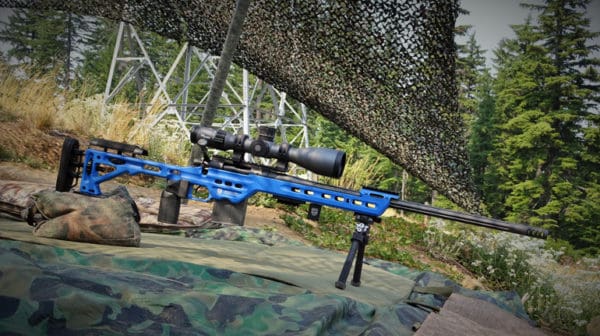
When building a custom rifle, LRI will generally use any barrel that the customer requests. That said, LRI owner Chad Dixon talked me out of using a carbon fiber Proof Research barrel.
He admitted that the Proof barrel was very accurate, but pointed out that it was also very expensive compared to a conventional steel barrel. Further, 6.5 Creedmoor has a moderately short barrel life. Given my relatively high volume of shooting, the barrel would last a year + or – .
Chad recommended K+P barrels a family-owned barrel manufacturer located in Rapid City, South Dakota.
I opted for barrel flutes, a $175 upgrade. In theory a fluted barrel offers some [admittedly trivial] increased surface area for cooling. I will admit I got it because it looks cool.
I’ve got roughly 1,500 rounds down this barrel, and so far the barrel has not disappointed. It requires only a minimal amount of maintenance, and it cleans up very quickly.
LRI Cathedral Muzzle Brake
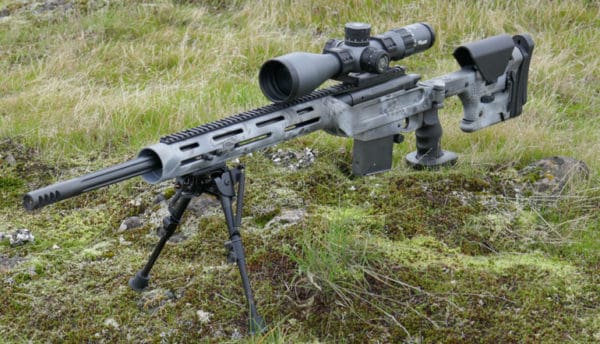
LRI’s cathedral muzzle brake was inspired by the intake port design of the General Motors LS-1 V-8 engine.
Rather than using the commonly encountered “gill” design, LRI’s cathedral brake features 3D surface machined ports with a progressive geometry that narrows as it moves towards the center bore.
According to LRI, it’s “a more elaborate and expensive way to manufacture a brake, but the performance we’ve enjoyed suggests a benefit.”
LRI only offers this brake for sale if they are installing the brake to the barrel. “Our manufacturing process is unique because the barreled action is integrated with the process. This ensures a perfect port index relative to the receiver.”
LRI blends the brake to barrel interface so that the brake appears to be part of the barrel.
As for its effectiveness, I haven’t tested this brake in any scientific manner. Based on my casual observations, recoil reduction seems on par with other designs I have tried. It doesn’t display any objectionable characteristics such as excessive noise (as compared to other brakes) or kick up excessive dust like designs with 360-degree ports.
JP AMCS Chassis with LRI Custom Cerekote

Over the years, I’ve gravitated to JP Rifles as my primary supplier of AR-15 parts. All told, JP parts now adorn eight of my AR-15s and AR-10s. So when it came time to build this rifle, I went with the JP Advanced Modular Chassis System (“AMCS”) chassis.

The AMCS Chassis is a stout 6061 T6 aluminum design intended to minimize flex and maximize accuracy. It is an extremely robust design. The chassis includes the precision-type tactical grip with palm shelf. I like the Ergo Grip with the palm swell better, but this a pretty good second choice.
The AMCS also features a fully adjustable Magpul butt stock. The Magpul isn’t a light buttstock, but it’s well thought out, and tough as nails. It accepts the Accu-Shot Monopod system.
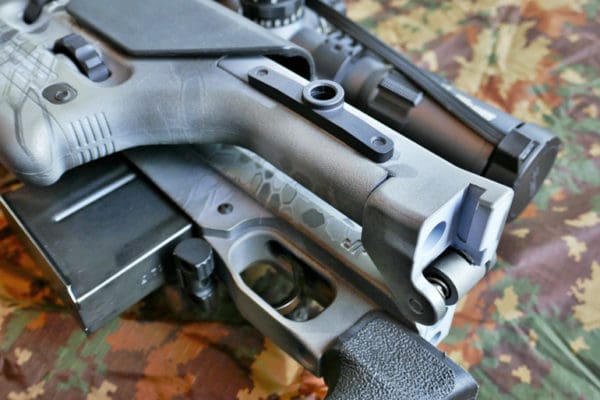
The AMAC chassis can also accept QD studs (aka “flush cups”) for QD sling systems at the handguard location and as part of the Magpul PRS stock.
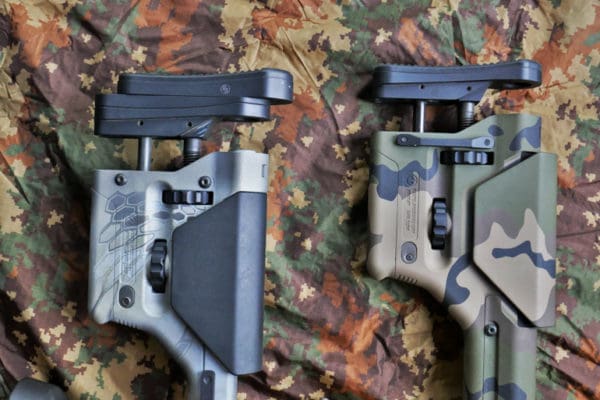
I bought the JP buttplate adapter for the Magpul PRS stock — a useful accessory (shown at top left in above photo).
The adapter allows for 2.5 inches upward and two inches downward adjustment from the standard PRS butt pad, as well as 10° left and right cant adjustment.
Magpul’s new gen III PRS stock eliminates the need for the JP part, but the JP part remains a recommended upgrade for older Magpul PRS stocks.
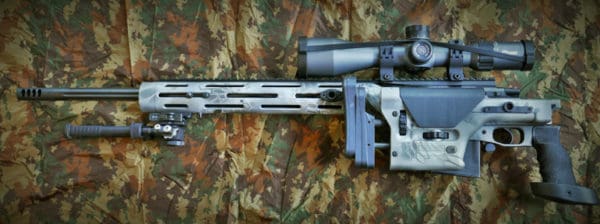
The AMCS stock also folds 180° to the left, and locks in place for storage in a smaller case.
While not the lightest design on the market, it’s not excessively heavy either. You can adjust the handguard so that it’s completely concentric with the barrel. That’s especially important if you’re using rail-mounted laser rangefinders and IR illuminators.
JP Rifles recently dropped the price on the AMCS chassis, from $1200-ish to $824.25.
The chassis market is evolving. Recent advancements in PRS stocks include features such as the Arca Swiss rails and adjustable barricade stops. JP needs to innovate if it wants to inroads into this market segment.
The PRS community is pushing rifle chassis technology to new heights. Companies like Masterpiece Arms, KRG, and XLR seem to have their finger on the pulse of what long range shooters want. JP needs to step it up. I know they will.
BTW… Long Rifles Inc. did the five-color Kryptec-inspired cerekote job.
Timney Two-Stage Calvin Elite 2 Stage Trigger
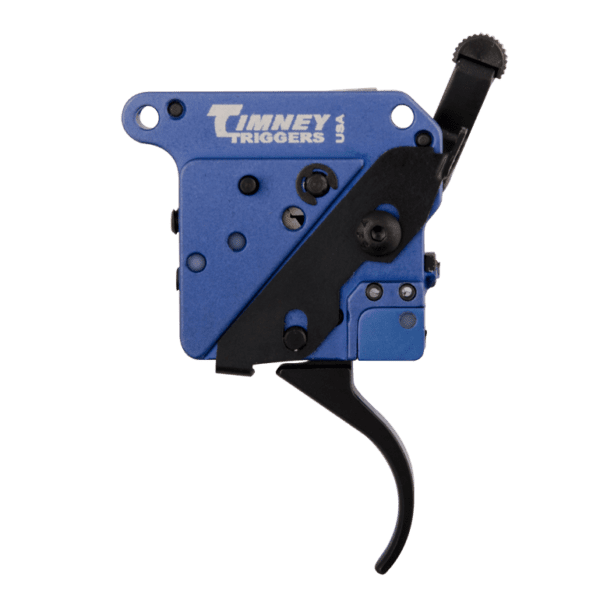
For this build, I opted for the Timney Calvin Elite trigger.
While I considered buying a trigger from Bix’n Andy or Jewell, I ended up saving a few bucks by getting the Timney on sale. And I’ve been content with the Timney. I set the trigger to break at 1 lbs. for each stage. Once you take up the slack, the Timney breaks with no objectionable creep and very little overtravel.
JP 10 Round Magazines.
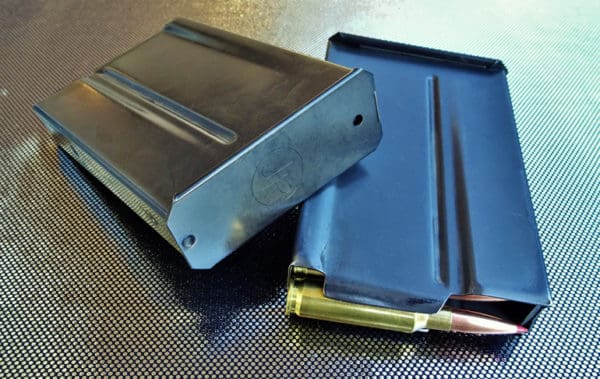
As mentioned above, the Mausingfield uses popular AICS magazines. I bought a couple of “JP”-branded 10-round magazines simply because they were reasonably priced on the JP website.
Accuracy

The Mausingfield is designed to be either a competition rifle or a high end long range hunting rifle.
Most competition-focused end users of these rifle builds will be using hand loads. I strongly suspect that a handloader can develop loads that will deliver ¼ MOA groups or better.
But I’m not a competition-level PRS shooter, and I really don’t have the time to reload. So my accuracy testing for this rifle has been limited to factory ammunition, the loads most commonly found at my local big-box store such as Cabela’s or Sportsman’s Warehouse, including:
– Hornady ELD 140 gr. Match
– Hornady ELD 120 gr. Match
– Hornady Precision Hunter 143 gr. ELD-X
– Hornady American Gunner 140 gr. BTHP
– Federal American Eagle 140 gr. Open Tipped Match.- Winchester 140 gr. BTHP Match
I shot roughly 500 rounds at the 100-yard line. Considering the average barrel life of a 6.5 Creedmoor is roughly 2,500 rounds, that’s a lot.
All of the factory “Match” offerings produced ½ MOA or better 5-shot groups, despite having a typical standard deviation between 12 to 35.
While some 5 shot groups were in the ¼ inch range or better, often one round out of five opened up the group. That’s probably me, but it’s hard to say. The rifle didn’t exhibit a strong preference for any one particular factory offering.
I’ve successfully taken this rifle out to 1400 yards. I think it’s capable of more distance if I can find the right shooting location.
Conclusion

Although not inexpensive, the feel of this action blows away anything else I own. The factory ammo is the limiting factor on accuracy; I need to step up and start reloading.
SPECIFICATIONS (Action).
Caliber: Right hand Long action and Short action available, leftie actions available as well
Bolt: 2 lug, 90 degree throw.
Multi-caliber capable: Yes, with interchangeable bolt heads.
Price: $1600.00

SPECIFICTIONS (Rifle)
Caliber: 6.5 Creedmoor
Capacity: 10+1.
Weight: 16.8 lbs., with AMAC Chassis, empty magazine, 42 oz. scope, ARC M-10 scope rings, and Atlas Bipod.
Length (AMAC buttstock extended): 46 inches
Length (AMAC buttstock folded): 38 inches.
Trigger: Timney Calvin Elite 2 stage (adjustable 8 ounce to 1.5 lb first stage and 8 ounce to 2.0 lb second stage).
Barrel: 24 inches, 1 in 8 twist.
Price (Street) without optic: Approximately $6,000.00 as shown.

RATINGS (Out of five stars):
Ergonomics: * * * * *
First rate.
Accuracy: * * * *
Consistent ½ MOA or better with Hornady 140 grain Match ammo.
Reliability: * * * * *
No issues. Perfection.
Overall: * * * * *
A great build (if I say so myself) that’s waiting for handloading perfection.

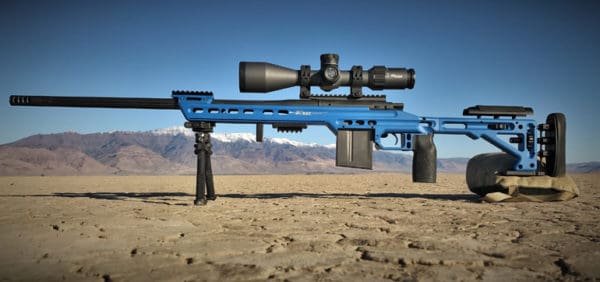



Are you in the NW? Love the pics.
jersey.
Thanks! Yes, I’m in PDX Oregon. Pics were taken in the Alvord desert, OR, Columbia River Gorge, WA, Lake Abert, OR (near K-Falls) and Mt Hood National Forest, OR.
that target is hurtling towards you. it seems you are aiming west.
“Brainchild behind”? No, the Mausingfield is the brainchild of Mr. Karagias. Let’s hope this isn’t the start of yet another blogger malaprop.
I guess I wasn’t using that work correctly. Changes made. thanks for the correction.
Beautiful rifle Joe!
I’m having some great accuracy using Berger bullets over the Hornady 143 ELD-X. I went from sub half inch to 1/4” and tighter.
And yeah, Ion Bond is quirky on their turnaround times.
Very nice rifle! Goes right to the top of my “Buy after winning lottery” list. And very thorough and informative review.
Thanks for the read! I’m glad you came in today and told me about your post. Those are certainly rifles to be proud of! If you ever want hand loads of 6.5 creedmoor, we should go shooting some time and see how factory loads compare. Also, I’ve heard of that legendary shooting spot, fantastic to actually see a photo of it.
This is a well written and thorough review and thanks again for telling me about it today.
So, you gave 4-stars to a 1/2 MOA rifle?!?! 🙂
If you love to wear vests? so get this amazing Red Puffer Vest which is a favorite of all girls and it is the most-rated and most selling outfit in our store, shop now because the stock is limited.
Comments are closed.